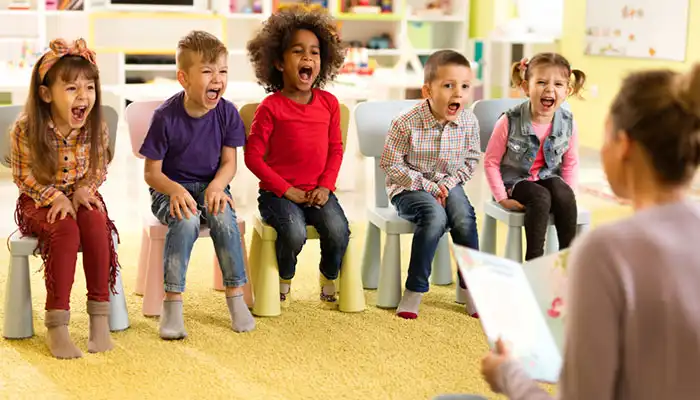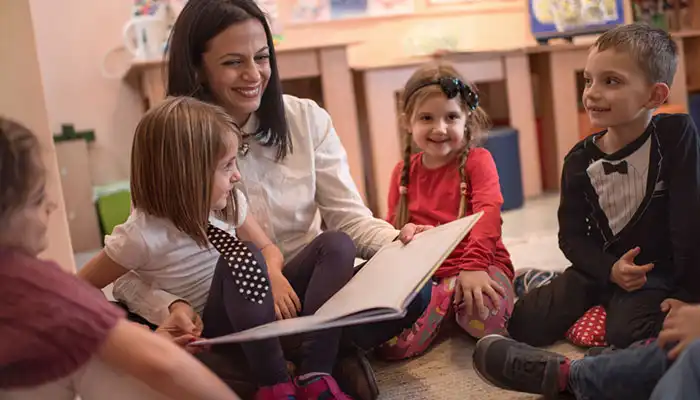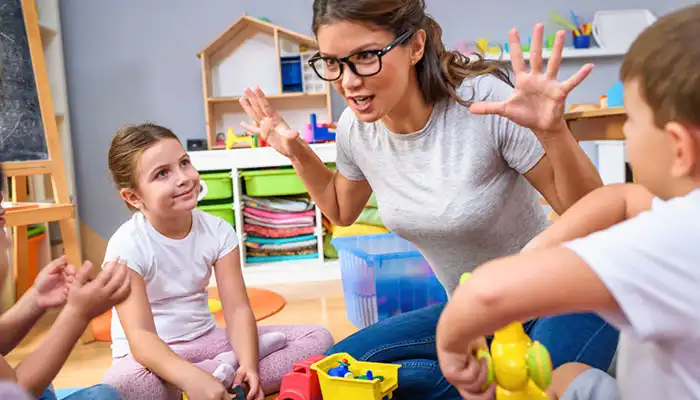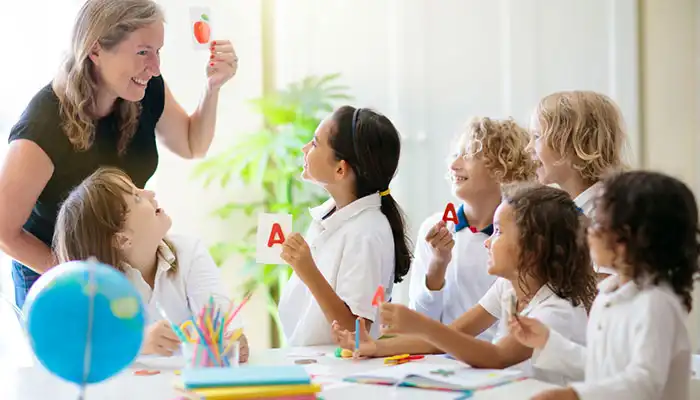Free Kindergarten-Level Storytelling Prompts Printable: Sparking Creativity in Young Learners
There is no better way to cultivate a child’s creativity than to teach them how to tell stories, whether it be yourself, as a parent or teacher, looking for a way to foster children’s creativity in preschool, kindergarten, 1st grade, or higher.
If you need to find exciting, yet easy tools for kindergarten storytelling activities, then you are at the right place. A kindergarten-level storytelling prompt can be very helpful when teaching kids how to write stories. This is a kindergarten storytelling skill.
Using storytelling prompts allow for one to tap into imaginative and creative ideas, some which they might have never even considered before. Using kindergarten storytelling prompts is one way to initiate that imaginary time needed for creativity to blossom.
Printable worksheets are available for these quick and easy activities, so you can turn storytelling into an exciting game for your preschooler, kindergartner, first grader, or any other child you are teaching. Printable worksheets are the best way to start teaching children how to write stories from scratch.

Why Storytelling Matters in Kindergarten
After all, storytelling is an essential component of early childhood. It’s not just that the process is enjoyable: children also develop language and cognitive skills by engaging with storytelling. When children listen to and retell stories, they develop their ability to organise their thoughts, build their vocabulary, and express themselves with clarity.
Imagine children, seated in a circle or gathered on a plush rug, having conversations about stories. Imagine them getting a real feel for how stories are put together. Imagine them happily filling in and creating storytelling prompts.
When given storytelling prompts, children will organize their ideas and create a story. Toddlers and preschoolers often need a story starter, a prompt to get them going. Teachers and parents usually do not want children telling unstructured stories.
The prompts included in these kindergarten storytelling prompt printable worksheets further guide the conversation and aid in organization of the story.
Benefits of Using Printable Storytelling Prompts
Beyond that, what are the concrete advantages from using printable storytelling prompts in a kindergarten setting? For starters, they provide structure for unleashing a child’s creativity. Kids need that little nudge to get to the creative part, after all.
These prompts help improve vocabulary and language skills, too: a child looks at a picture of a castle and a dragon, not just to imagine a story but to learn to use descriptive language, come up with new words, and find ways to express them.
The other benefit – here, I argue – is the greater understanding of story structure that can emerge from these prompts. Children learn that a story will have a beginning, middle and an end. For instance, ‘Once upon a time in a faraway land,’ might be a follow-on prompt to get children thinking about what could be next to happen.
How to Use Storytelling Prompts at Home and in the Classroom
Now, we get to the practical. How to use these free preschool-level storytelling prompt printable sheets in your daily life? Whether at home or in the classroom, these tips will come in handy.
- Starting Simple: Go for obvious, easy prompts and relate them to your child’s interests. For example, if they love animals, give them animal prompts first to focus them and make it – and its results – more accessible to them.
- MAKE IT SALIENT: Promote interactive play in which children can tell their stories to one another, which creates audience engagement and builds confidence, while also offering opportunities for peer learning.
- Images: Several of these free printable home learning ideas also come with images. You can use these pictures to question and comment. For example, you can say: ‘What do you think he is doing here?’ or ‘What will happen at the end of the story?
- Routine Time: Weave storytelling prompts into your daily or weekly routine. For instance, start each morning with a new prompt, encouraging children to pursue the story throughout the day.
Free Printable Storytelling Prompts for Kindergarten
These free kindergarten-level storytelling prompts printable sheets are for little learners – a simple scenario followed by several details or outcomes that’s easy for kids to imagine or elaborate on. Here are some examples:
A visit to the zoo: You are going to the zoo. What animals do you see? What are they doing?
- A Magic Forest: You are in a magic forest. What do you see? What creatures do you meet? What do you do?
A: The Lost Treasure: You discover a mysterious map. Where does it go? What dangers await you along your path?
These are certainly not work-sheets but rather imagination triggers. Letting your child make their own story gives them skills in critical thinking and an understanding of language.
Encouraging Continuous Practice and Improvement
Storytelling isn’t an activity that can be done just once. To really get the benefit from these prompts, you have to get people practising continuously. Here’s how.
- Set up a Storytelling Routine: Maybe it’s a morning meeting or just before lunch. Pick a schedule and stick to it.
- Give Feedback: As the child tells her story, offer positive feedback. Praise his creativity, and make suggestions on how to make it better. For instance, if the story ends abruptly, you might say: ‘What happens next?
- Draw the Story: Encourage children to draw pictures to accompany their story. This not only supports creative thinking but helps young people illustrate the story within their own mind.
Additional Resources for Storytelling and Writing
But these are of course just free printable kindergarten-level storytelling prompts. You can get a lot more if you’re ready to invest. The internet is full of educational websites and apps that turn storytelling into a game, so your child can play and practise storytelling at the same time. A scene with a wonder balloon.
Books are another excellent resource. Search for titles that are there to stimulate imagination and provide examples of solid storytelling, as well as apps that allow their stories to be recorded.

Bringing It All Together
One easy way to encourage this at home or at school is to weave free kindergarten-level storytelling prompts printable sheets into your child’s or students’ daily work. These supports are structured and unstructured at the same time. They provide performative constraints that give young storytellers a framework for exploration and fiction-building, as well as an opportunity to grow their confidence and develop important literacy skills.
No matter if you are a parent looking for easy-to-use printable storytelling prompts to foster a fun learning experience at home, or if you are a teacher who wants new, crafty ways to engage children and enhance their literacy, this tool can aid and even inspire you. Give it a try today and watch your young storytellers thrive.
Integrating Storytelling Prompts into Different Learning Areas
If you are using kindergarten level storytelling prompts printable sheets, it would be beneficial to think how they can fit in with a range of subjects and activities. By adding a storytelling element to different areas of learning, you can easily tailor some storytelling to your child’s current subject matter or learning activity at school or at home.
- Literacy Development:
First, consider how story starter prompts can improve literacy. Because a prompt is explicitly an opportunity for a child to tell a story, it’s an opportunity for a child to practise reading and writing about it, too. For example, after a child creates something based on a story starter, ask her to step back and write down her story. This not only reinforces the process of storytelling but also leaves her with a tangible piece of writing to work on, something that can help her with spelling, grammar, sentences and word order.
- Social and Emotional Learning:
It also happens to be an excellent means of building empathy and talking about feelings. Prompts that ask students to imagine what the character is thinking through a challenge or decision are especially conducive to discussions involving emotions and how people react to one another: ‘How do you think the character was feeling when that happened?’ ‘What would you do in that situation?’ By guiding children to think about how a character is feeling in response to certain circumstances, they can begin to identify how their own and other people’s feelings are linked.
- Art and Creativity:
Bring art into the process – for example, let children draw a picture for every part of their story. You can expand this into more elaborate activities such as comic strips. This helps them develop their visual storytelling skills and think creatively.
- Math and Logic:
Yes, even math! Perhaps a cue would include a character who needs a solution involving numbers or logic of some kind: in addition to the storytelling space, another mechanical space exists – maybe the kids need to count various objects or recognise some pattern, maybe it’s about basic addition and subtraction, and so on.
FAQs about Using Free Kindergarten-Level Storytelling Prompts Printable
Let’s now tackle the obvious questions that parents and teachers might have about using these storytelling prompts.
1) Will my child be able to develop an extended story from these writing prompts?
We can’t know that for sure since we haven’t seen your child’s writing. Children vary in their abilities. However, if your child struggles to complete a short paragraph, then an extended story is probably not the best fit.
Think back to when your child first started school – they likely started by copying letters and sounded out words.
They didn’t go from there straight to writing 1,000-word book reports. At that time, it was more developmentally appropriate for your child to work on copying simple words, just as you wouldn’t give a five-year-old calculus problems To learn more about child development and help your child build skills and confidence, discover our podcasts at Talking to Kids.
Q: How often should I use storytelling prompts with my child?
A: Keep it consistent. Try to incorporate the storytelling stimuli in routines that you do with your child on a daily or weekly basis, to help them build confidence and grow their language and creative skills every step of the way.
Q: What if my child struggles with creating stories?
A: Start with very simple directives, and add complexity when you see that they get more confident in themselves. Celebrate small successes and reward positively to motivate them As a parent, you can provide exemplary stories by creating them together with your child, thus guiding him or her through the process.
Q: How can I make storytelling prompts more interactive?
A: Use props or other visual aids connected to the prompts. Here, it might involve selecting some toy animals or drawings of trees if the prompt is a magical forest.
Q: Are these storytelling prompts suitable for group activities?
A: Yes, absolutely – especially when in a classroom, a storytelling prompt is a great activity to do with children in a group, to encourage collaboration, listening skills and the sharing of a narrative or idea. Each child could contribute a little of the story so that each part is a collective creation.
Q: How can I assess my child’s progress in storytelling?
A: Look for things such as improvements in vocabulary and sentence structure and the growth in complexity of the stories. Comments on how they go about expressing their ideas and how involved they become in the process of telling the story can help them improve over time. Regular constructive feedback and gentle encouragement is also supportive of progress.
Creating a Storytelling Environment at Home
In order to make maximum use of these easy-to-print, kindergarten-level story starters, do your best to cultivate your child’s sense of play and imagination. Here are some things you can do.
- Designate a Storytelling Space:
So choose a nook in your home, somewhere comfortable and inviting to tell stories – a corner with pillows on the floor, a low table covered in storybooks, prompts and pencils, their very own blanket fort – someplace your child can get cozy and play pretend.
- Use a Story Box:
Put lots of everyday items into a box – toy figures, postcards, small objects – that could be used in stories. All of these items will be characters or plot points. Once your child has understood this, they can close their eyes and pull something out of the box to begin the story.
- Incorporate Technology:
And there are apps and websites that allow kids to create simple digital storybooks, such as Lumio, or to record themselves telling their own stories. This can also spark a techy kid’s interest, making storytelling extra interactive and engaging.
- Storytelling as a Family Activity:
Make it a family affair. Every family member adds a line or paragraph to help the story along. Not only will this make storytelling fun but your child will also learn that storytelling is part of the value of being a family.
Encouraging Storytelling in the Classroom
Free kindergarten-level storytelling prompts printable are great tools in the classroom if you’re a teacher. Heres how to use them!
- Morning Story Circle:
Start the day with a storytelling circle. Let everyone contribute a line or a small image to a story based on a prompt this is a nice positive creative way to begin the day.
- Storytelling Journals:
Let each child keep a journal in which they write their stories or draw pictures on the subject of the day’s prompt. This becomes their archive of contributions and their pathway for growth.
- Peer Sharing Sessions:
Have the children share stories with each other – in groups of no more than six, or the whole class. Peer feedback is highly encouraging, and children can benefit from learning from one another.
- Story-Related Games:
Make the stories into a game. Try rolling a ‘story dice’ every now and then, with, say, six sides; each one will represent a character, setting or object that you must put into your story. Kids love the variability.
The Long-Term Benefits of Storytelling Prompts
So, although use of a free kindergarten kind of creative writing warm-up – like the above – might help with prompt engagement in the here and now, it also has long-term, big picture benefits. Here’s how:
- More eloquent language: Children become more eloquent in their vocabulary, sentence formation and narrative over the years. These skills set them up for later school success.
- The power of critical thinking: One of the great benefits of storytelling is that it gets children thinking, not just about the story they are hearing but about how stories work. All of these questions can be directed at all kinds of stories to develop ‘meta-cognitive’ skills the student will draw on in all areas of learning, as well as for problem-solving more generally.
- Better Creativity: Storytelling prompts encourage us to think outside of the box. We ask children to tell ‘what if’ stories – what would happen if a particular character did this or had that ability? These questions require a degree of creativity, since most things that the characters do or have aren’t part of the immediate story.
- Confidence Building: As children gain confidence in the process and product of story-making, sculpting plots, developing characters, giving voice to their ideas, the practice spills over into other arenas, from public speaking to creative writing.
Final Thoughts on Free Kindergarten-Level Storytelling Prompts Printable
Free kindergarten-level storytelling prompts printable can be worked into your child’s schedule as a creative, language-building, developmentally-supportive activity that will help your kids grow to become their most dynamic selves. Are you a parent wanting to enrich your child’s learning time at home? Or a teacher hoping to spice up your students’ classroom learning time? Whether you are at home or in a classroom setting, these free kindergarten-level storytelling prompts printable can help.
By bringing these mini-prompts into your routine, you are giving your child not only a ritual for how to tell stories, but the foundational skills to express his thoughts, analyse problems, and broaden his imagination. Without knowing it, that next Etch-A-Sketch tale could be the foundation for tomorrow’s novelist, speechmaker – maybe even philosopher.



